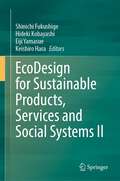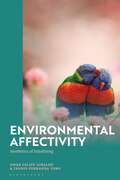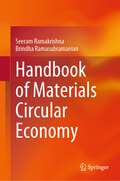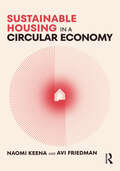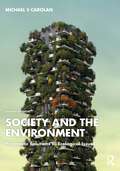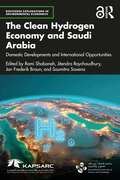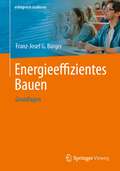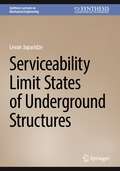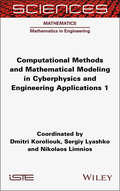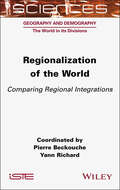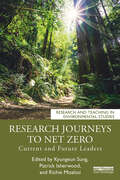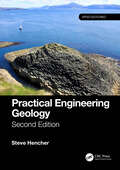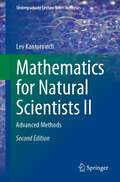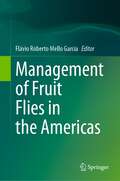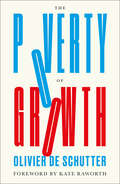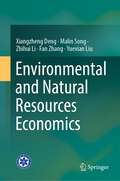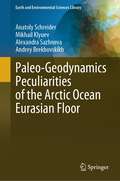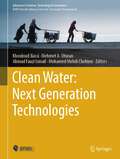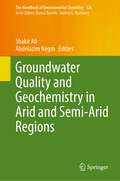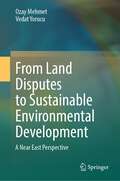- Table View
- List View
EcoDesign for Sustainable Products, Services and Social Systems II
by Shinichi Fukushige Hideki Kobayashi Eiji Yamasue Keishiro HaraThis 2-volume book highlights cutting-edge ecodesign research and covers broad areas ranging from individual product and service design to social system design. It includes business and policy design, circular production, life cycle design and management, digitalization for sustainable manufacturing, user behavior and health, ecodesign of social infrastructure, sustainability education, sustainability indicators, and energy system design. Featuring selected papers presented at EcoDesign 2021: 12th International Symposium on Environmentally Conscious Design and Inverse Manufacturing, it also includes diverse, interdisciplinary approaches to foster ecodesign research and activities. In the context of Sustainable Development Goals (SDGs), in particular SDG 12 (Responsible Consumption and Production), it addresses design innovations for sustainable value creation, considering technological developments, legislation, and consumer lifestyles. Further, the book discusses the conceptof circular economy, which aims to develop circular business models for resource efficient society by taking advantage of digital technologies including artificial intelligence, internet of things, digital twin, data analysis and simulation. Written by experts from academia and industry, Volume 2 focuses on the sustainability assessment of product lifecycle, waste management, material circularity and energy efficiency, food and agriculture, user behavior and health, and transportation. The methods, tools, and practices described are useful for readers to facilitate value creation for sustainability.
Environmental Affectivity: Aesthetics of Inhabiting
by Dr Omar Felipe Giraldo Ms Ingrid Fernanda ToroFollowing Spinoza's lead and Latin American environmental thought, this book imagines an embodied environmental ethics based on the relations between sentient beings and sustained by affections, sensibility, the senses, and contact. Engaging embodied, cognitive, phenomenological, aesthetic and psychoanalytic aspects of affectivity, Omar Felipe Giraldo and Ingrid Fernanda Toro help us understand how places inhabit us, and therefore, how places transformed lovingly have the immense capacity to modify the body, to redirect desire, to clarify our sensibility – creating an affectivity in direction opposition to the regime imposed by this global ecocidal capitalism.For the authors, the environmental crisis is more than a technological or economic problem. They see it as a threat to survival inscribed in the deepest foundations of our body, in the intimacy of our skin, in the intensity and tone of our affections, in our desires, in our perceptions and in our sensory-motor capacities. Hence, the immense need to dismantle this system of power embedded in the intimacy of our body and to cultivate a perceptual transformation guided by an empathic knowledge that leads to a different understanding of our belonging in that which exceeds us. This book is a vital manifesto on the political role of affects, an invitation to awaken the sensitive perception anesthetized by the ecologies of cruelty, and an urgent call to understand differently our place in the cosmos in the midst of this war that our civilization has declared on life.
Handbook of Materials Circular Economy
by Seeram Ramakrishna Brindha RamasubramanianThis book provides comprehensive and practical information on the design and implementation of circular systems for various industries, with a focus on Environmental, Social, and Governance (ESG) factors. The scope of the handbook is to cover the materials circularity in a deeper analysis in accordance to ESG used in various industries such as oil and gas, IT, electronics, medicine, textile, and more. The handbook also covers the key principles of the circular economy, including material efficiency, resource conservation, and waste reduction, and how they impact to different industries. It further critically analyses the challenges and opportunities associated with implementing circular systems in these industries, including the framework for new business models and technical innovations, and the potential benefits in terms of environmental protection, social responsibility, and economic competitiveness. In addition to providing practical information, the handbookalso addresses the ESG factors associated with the circular economy exclusively for each industry. This would include the impact of circular systems on the environment, including the reduction of greenhouse gas emissions and the protection of biodiversity, as well as the social benefits, such as job creation, and the economic benefits, such as cost savings and increased competitiveness. The ultimate goal of the handbook should be to provide guidance and support in a niche evaluation for the development of a more sustainable and equitable future, where the circular economy is a key enabler.
Environmental Affectivity: Aesthetics of Inhabiting
by Dr Omar Felipe Giraldo Ms Ingrid Fernanda ToroFollowing Spinoza's lead and Latin American environmental thought, this book imagines an embodied environmental ethics based on the relations between sentient beings and sustained by affections, sensibility, the senses, and contact. Engaging embodied, cognitive, phenomenological, aesthetic and psychoanalytic aspects of affectivity, Omar Felipe Giraldo and Ingrid Fernanda Toro help us understand how places inhabit us, and therefore, how places transformed lovingly have the immense capacity to modify the body, to redirect desire, to clarify our sensibility – creating an affectivity in direction opposition to the regime imposed by this global ecocidal capitalism.For the authors, the environmental crisis is more than a technological or economic problem. They see it as a threat to survival inscribed in the deepest foundations of our body, in the intimacy of our skin, in the intensity and tone of our affections, in our desires, in our perceptions and in our sensory-motor capacities. Hence, the immense need to dismantle this system of power embedded in the intimacy of our body and to cultivate a perceptual transformation guided by an empathic knowledge that leads to a different understanding of our belonging in that which exceeds us. This book is a vital manifesto on the political role of affects, an invitation to awaken the sensitive perception anesthetized by the ecologies of cruelty, and an urgent call to understand differently our place in the cosmos in the midst of this war that our civilization has declared on life.
Sustainable Housing in a Circular Economy
by Naomi Keena Avi FriedmanThis book relates circular economy principles to housing design and construction and highlights how those principles can result in both monetary savings, positive environmental impact, and socio-ecological change.Chapters focus on three key circular economy principles and apply them to architectural construction and design, namely rethinking of the end-of-use phase of a building and the potential of design-for-disassembly; the role of digitization and data standardization in fostering evidence-based circular economy design decision-making; and presenting space as a resource to conserve, via exploration of the sharing economy and flexibility principles. Beyond waste management and material cycles, this book provides a holistic understanding of the opportunities across the building life cycle that can allow for sustainable and affordable circular housing. With case studies from 13 different countries, including but not limited to the Hammarby Sjöstad district in Sweden, the Circle House in Denmark, Benny Farm in Canada, VMD Prefabricated House in Mexico, and the Deep Performance Dwelling in China, authors pair theoretical frameworks with real-world examples.This will be a useful resource for upper-level students and academics of architecture, construction, and planning, especially those studying and researching housing design, building technology, green project management, and environmental design.
Sustainable Housing in a Circular Economy
by Naomi Keena Avi FriedmanThis book relates circular economy principles to housing design and construction and highlights how those principles can result in both monetary savings, positive environmental impact, and socio-ecological change.Chapters focus on three key circular economy principles and apply them to architectural construction and design, namely rethinking of the end-of-use phase of a building and the potential of design-for-disassembly; the role of digitization and data standardization in fostering evidence-based circular economy design decision-making; and presenting space as a resource to conserve, via exploration of the sharing economy and flexibility principles. Beyond waste management and material cycles, this book provides a holistic understanding of the opportunities across the building life cycle that can allow for sustainable and affordable circular housing. With case studies from 13 different countries, including but not limited to the Hammarby Sjöstad district in Sweden, the Circle House in Denmark, Benny Farm in Canada, VMD Prefabricated House in Mexico, and the Deep Performance Dwelling in China, authors pair theoretical frameworks with real-world examples.This will be a useful resource for upper-level students and academics of architecture, construction, and planning, especially those studying and researching housing design, building technology, green project management, and environmental design.
Society and the Environment: Pragmatic Solutions to Ecological Issues
by Michael S CarolanThe fourth edition of Society and the Environment centers its discussion on realistic solutions to the problems that persist and examines current controversies within a socio‑organizational context, shifting focus away from simply explaining what is wrong with the world around us. Introducing this “pragmatic environmentalism,” Carolan discusses the complex pressures and variables that exist where ecology and society collide, with population growth, the increase in demands for food and energy, and transportation and its outsized influence on urban and community patterns. With further attention given to the social phenomena and structural dynamics driving today’s environmental problems, the book concludes with an important reflection on truly sustainable solutions and what constitutes meaningful social change.Each chapter in this interdisciplinary text follows a three‑part structure beginning with an overview of what is wrong and why. This leads into a discussion on each issue’s wide‑ranging implications and, finally, a balanced consideration of realistic solutions. Featuring updated and expanded examples, discussion points, and coverage of recent developments, including the US withdrawing from the Paris Agreement, “booming” national economies and wealth distribution, growing global interest in environmental justice—with particular focus on the links between injustice and race and inequality—climate change, and renewable energy, this new edition remains an essential companion for courses on environmental sociology and sustainability.
Society and the Environment: Pragmatic Solutions to Ecological Issues
by Michael S CarolanThe fourth edition of Society and the Environment centers its discussion on realistic solutions to the problems that persist and examines current controversies within a socio‑organizational context, shifting focus away from simply explaining what is wrong with the world around us. Introducing this “pragmatic environmentalism,” Carolan discusses the complex pressures and variables that exist where ecology and society collide, with population growth, the increase in demands for food and energy, and transportation and its outsized influence on urban and community patterns. With further attention given to the social phenomena and structural dynamics driving today’s environmental problems, the book concludes with an important reflection on truly sustainable solutions and what constitutes meaningful social change.Each chapter in this interdisciplinary text follows a three‑part structure beginning with an overview of what is wrong and why. This leads into a discussion on each issue’s wide‑ranging implications and, finally, a balanced consideration of realistic solutions. Featuring updated and expanded examples, discussion points, and coverage of recent developments, including the US withdrawing from the Paris Agreement, “booming” national economies and wealth distribution, growing global interest in environmental justice—with particular focus on the links between injustice and race and inequality—climate change, and renewable energy, this new edition remains an essential companion for courses on environmental sociology and sustainability.
The Clean Hydrogen Economy and Saudi Arabia: Domestic Developments and International Opportunities (Routledge Explorations in Environmental Economics)
This book provides a first-of-its-kind analysis of the emerging global hydrogen economy from the vantage point of one of the world’s biggest energy providers: Saudi Arabia. In 2021, and within the context of the Circular Carbon Economy framework, Saudi Arabia announced its goal to reach net-zero carbon emissions by 2060 and produce a substantial amount of clean hydrogen annually by 2030. The Kingdom is optimally situated geographically between the major demand markets in Europe and North Asia, from where it can leverage clean hydrogen exports as a potential tool to become a player of strategic importance and successfully diversify its economy under its Vision 2030 program. More broadly, the book charts a course for fossil fuel-exporting countries such as Saudi Arabia to carve a competitive position for themselves over the forthcoming decades using clean hydrogen as a catalyst for the energy transition.With contributions from global energy experts, the chapters in this book provide a multifaceted analysis of the "who," "what," "where," and "why" related to clean hydrogen development within and beyond Saudi Arabia. Collectively, the contributions analyze the countries and regions relevant to Saudi Arabia in terms of dedicated hydrogen policies, projects, and approaches that aim to incentivize production and demand in an increasingly carbon-constrained world. The book is a timely, unique and an indispensable resource for practitioners and students of energy, geopolitics, and climate policy working on hydrogen in academia, applied research, national government bodies, and international organizations.
Energieeffizientes Bauen: Grundlagen (erfolgreich studieren)
by Franz-Josef G. BürgerDer Arbeitsbereich des „Energieeffizienten Bauens“ bietet eine gute Zukunftsperspektive. Die fachliche Auseinandersetzung mit dem Thema „Energieeffizientes Bauen“ erfordert interdisziplinäres Arbeiten. Architekten und Bauingenieure werden bei der Planung und Ausführung der gebäudetechnischen Einrichtungen zunehmend mit den Aufgabenstellungen des Maschinenbaus und der Elektrotechnik konfrontiert. Die Buchinhalte beschreiben die naturwissenschaftlichen Grundlagen für die richtige Wahl der Baumaterialien und Baukonstruktionen im Hinblick auf Energieeffizienz, Nachhaltigkeit und Methoden zur Wirtschaftlichkeitsbetrachtung. Aufgaben am Ende der Kapitel ermöglichen die Selbstkontrolle und Festigung des angeeigneten Wissens.
Serviceability Limit States of Underground Structures (Synthesis Lectures on Mechanical Engineering)
by Levan JaparidzeThe main topic of this book is the calculation of underground structures at the limit states of serviceability. It considers the main schemes typical for underground structures for various purposes, gives the corresponding mathematical models describing the main geo-mechanical and technological factors in the construction and operation of extended excavations. Generalized criteria are proposed for making a technically and economically justified solution of the problem of determining the optimal forms and sizes of workings, bearing capacity, type of support and its erection, depending on the structural features of the rock mass, the primary stress fields of gravitational, tectonic, seismic acting in it. and technological origins, operational requirements for extended excavations. The corresponding algorithms, block diagrams and specific numerical examples of calculations are given. In most of the existing calculation methods the structure is considered in the elastic stage, the strength limit of the bearing capacity is considered as the moment when the maximum internal stresses reach the corresponding design resistances of the material. If it is legitimate to use this criterion in certain cases of calculation of statically determinable structures operating in the given loading mode, then in cases where the support operates in the mode of mutually influencing deformation together with the rock mass, it leads to a significant waste of material.
Computational Methods and Mathematical Modeling in Cyberphysics and Engineering Applications 1
by Dmitri Koroliouk Sergiy Lyashko Nikolaos LimniosMathematical methods in engineering are characterized by a wide range of techniques for approaching various problems. Moreover, completely different analysis techniques can be applied to the same problem, which is justified by the difference in specific applications. Therefore, the study of the analyses and solutions of specific problems leads the researcher to generate their own techniques for the analysis of similar problems continuously arising in the process of technical development. Computational Methods and Mathematical Modeling in Cyberphysics and Engineering Applications contains solutions to specific problems in current areas of computational engineering and cyberphysics.
Regionalization of the World: Comparing Regional Integrations
by Pierre Beckouche Yann RichardOn the world map, macro-regions or global regions have gradually emerged, with varying degrees of success and following different trajectories. The authors of this book attempt to determine whether, within the context of globalization, these macro-regions have become an additional level in the spatial deployment of numerous actors, and whether they have come to stand between the national and global levels. This question has arisen because the increasing scales of trade, environmental problems, migration routes, energy distribution, the construction of major infrastructures etc. transcend national boundaries and are leading states to implement macro-regional cooperation. The authors ask whether these large regional groupings are becoming genuine territories and are the fruit of in-depth regional integration – economic, institutional, legal, normative, political, cultural and in terms of identity. If so, these global regions would therefore become referents that make sense and take root in social representations.
Research Journeys to Net Zero: Current and Future Leaders (Research and Teaching in Environmental Studies)
This book provides useful insight into how academics from diverse disciplinary backgrounds, such as science, engineering, technology, social science, policy, design, architecture, built environment, business, and management, have been conducting research into how to realise net zero emissions to address climate change. This book explores the ways in which countries around the world have pledged to achieve net zero emissions through decarbonisation processes. It presents the highest calibre research and impact activities carried out in the UK, Europe, North America, Australia, Asia, and Africa. Such activities include conceptualisation, opportunity identification, specific case studies, demonstration of proof of concepts, provision of evidence, education of the general public, and knowledge transfer to companies. Further to this, the chapters also bring to light personal career journeys to net zero by current and future international research leaders. From this book, readers will gain a full understanding of net zero research via multiple disciplinary pathways, be inspired by personal accounts, and will learn key methodologies, including quantitative and qualitative approaches. The diversity of authors and topics make the book widely applicable to a range of fields, and it will be of great interest to researchers, students, practitioners, and decision makers working towards the goals of net zero and decarbonisation.
Research Journeys to Net Zero: Current and Future Leaders (Research and Teaching in Environmental Studies)
by Kyungeun Sung Patrick Isherwood Richie MoalosiThis book provides useful insight into how academics from diverse disciplinary backgrounds, such as science, engineering, technology, social science, policy, design, architecture, built environment, business, and management, have been conducting research into how to realise net zero emissions to address climate change. This book explores the ways in which countries around the world have pledged to achieve net zero emissions through decarbonisation processes. It presents the highest calibre research and impact activities carried out in the UK, Europe, North America, Australia, Asia, and Africa. Such activities include conceptualisation, opportunity identification, specific case studies, demonstration of proof of concepts, provision of evidence, education of the general public, and knowledge transfer to companies. Further to this, the chapters also bring to light personal career journeys to net zero by current and future international research leaders. From this book, readers will gain a full understanding of net zero research via multiple disciplinary pathways, be inspired by personal accounts, and will learn key methodologies, including quantitative and qualitative approaches. The diversity of authors and topics make the book widely applicable to a range of fields, and it will be of great interest to researchers, students, practitioners, and decision makers working towards the goals of net zero and decarbonisation.
Practical Engineering Geology (Applied Geotechnics)
by Steve HencherPractical Engineering Geology provides an introduction to the way projects are managed, designed and constructed, and how the engineering geologist can contribute to cost- effective and safe project achievement. The need for a holistic view of geological materials, from soil to rock, and of geological history is emphasised. Chapters address key aspects of• Geology for engineering and ground modelling• Site investigation and testing of geological materials• Geotechnical parameters• Design of slopes, tunnels, foundations, and other engineering structures• Identifying hazards• Avoiding unexpected ground conditionsThis second edition includes a new chapter on environmental issues covering hydrogeology, considerations of climate change, earthquakes, and more. All chapters have been updated, with extensively revised figures throughout and several new case studies of unexpected ground conditions. The book will support practising engineering geologists and geotechnical engineers, as well as MSc level students of engineering geology and other geotechnical subjects.
Practical Engineering Geology (Applied Geotechnics)
by Steve HencherPractical Engineering Geology provides an introduction to the way projects are managed, designed and constructed, and how the engineering geologist can contribute to cost- effective and safe project achievement. The need for a holistic view of geological materials, from soil to rock, and of geological history is emphasised. Chapters address key aspects of• Geology for engineering and ground modelling• Site investigation and testing of geological materials• Geotechnical parameters• Design of slopes, tunnels, foundations, and other engineering structures• Identifying hazards• Avoiding unexpected ground conditionsThis second edition includes a new chapter on environmental issues covering hydrogeology, considerations of climate change, earthquakes, and more. All chapters have been updated, with extensively revised figures throughout and several new case studies of unexpected ground conditions. The book will support practising engineering geologists and geotechnical engineers, as well as MSc level students of engineering geology and other geotechnical subjects.
Mathematics for Natural Scientists II: Advanced Methods (Undergraduate Lecture Notes in Physics)
by Lev KantorovichThis textbook, the second in a series (the first covered fundamentals and basics), seeks to make its material accessible to physics students. Physics/engineering can be greatly enhanced by knowledge of advanced mathematical techniques, but the math-specific jargon and laborious proofs can be off-putting to students not well versed in abstract math. This book uses examples and proofs designed to be clear and convincing from the context of physics, as well as providing a large number of both solved and unsolved problems in each chapter. This is the second edition, and it has been significantly revised and enlarged, with Chapters 1 (on linear algebra) and 2 (on the calculus of complex numbers and functions) having been particularly expanded. The enhanced topics throughout the book include: vector spaces, general (non-Hermitian, including normal and defective) matrices and their right/left eigenvectors/values, Jordan form, pseudoinverse, linearsystems of differential equations, Gaussian elimination, fundamental theorem of algebra, convergence of a Fourie series and Gibbs-Wilbraham phenomenon, careful derivation of the Fourier integral and of the inverse Laplace transform. New material has been added on many physics topics meant to illustrate the maths, such as 3D rotation, properties of the free electron gas, van Hove singularities, and methods for both solving PDEs with a Fourier transform and calculating the width of a domain wall in a ferromagnet, to mention just a few. This textbook should prove invaluable to all of those with an interest in physics/engineering who have previously experienced difficulty processing the math involved.
Management of Fruit Flies in the Americas
by Flávio Roberto Mello GarciaThis book comprises issues at the cutting edge of fruit fly management in the Americas, covering topics that are focal points of current activity and likely long-term importance to the progress of the field. The book is an invaluable source of ideas and inspiration for entomologists at all levels from graduate students to more-established researchers and professionals. Fruit flies (Diptera, Tephritidae) is the most important pests of fruit production worldwide. The purpose of this book is to integrate the experiences of leading scientists in the management of fruit flies in the Americas. In this work, species of fruit flies of economic importance are considered in the genera Anastrepha, Rhagoletis, Bactrocera, and Ceratitis. This book will address fruit flies monitoring, biological control, chemical control, cultural control, sterile insect technique (SIT), Integrated Pest Management (IPM), and other control methods. The book provides invaluable resource material to scientists, professionals and students.
The Poverty of Growth
by Olivier De Schutter‘Lucid, calm and compelling – Olivier De Schutter tackles the big question – how do we move forward from outdated economic thinking to a sustainable prosperity for all?’ Kate Pickett, co-author, The Spirit Level: Why Equality is Better for EveryoneHow do we combat poverty and rising inequality? In our age of impending climate catastrophe, the conventional wisdom around economic growth is no longer fit for purpose; a rising tide sinks all boats.Oliver De Schutter believes that we must fundamentally rethink the fight against poverty. The quest for growth not only clashes with the need to remain within planetary boundaries, but also creates the very social exclusion it is intended to cure: eroding human rights, widening inequality, and modernising poverty without eliminating it.The Poverty of Growth is a clarion call to forge a new path demanding progress that is no longer focused on wealth and profit.Olivier De Schutter is the United Nations Special Rapporteur on extreme poverty and human rights. Previously, he has been the UN Special Rapporteur on the right to food, and a member of the UN Committee on Economic, Social and Cultural Rights. He is the co-author of The Escape from Poverty and Social Innovation in the Service of Ecological and Social Transformation: The Rise of the Enabling State.
Environmental and Natural Resources Economics
by Xiangzheng Deng Malin Song Zhihui Li Fan Zhang Yuexian LiuThis book aims to integrate multiple disciplinary such as management, economics, and geography from the perspective of resource science and also to strengthen research on resource management to promote sustainability in natural resources. It established clear definition of natural resources and in-depth exploration of main fields such as water resources, land resources, and agricultural resources. Classic methods of economics are applied to solve the problems of resource consumption, environmental pollution, and climate change in modern society. On the basis of classical economics, the disciplinary system of environmental and natural resources is further developed. It is a helpful reference for readers to further study natural resources and environmental economics.
Paleo-Geodynamics Peculiarities of the Arctic Ocean Eurasian Floor (Earth and Environmental Sciences Library)
by Anatoly Schreider Mikhail Klyuev Alexandra Sazhneva Andrey BrekhovskikhThe book deals with some issues of paleo-geodynamics of the Eurasian floor of the Arctic Ocean.A comprehensive geological and geophysical analysis of information on the anomalous magnetic field in the Eurasian Basin was carried out using modeling of the inversion magnetically active layer of the oceanic crust. As a result of this analysis, the identification and spatial position of linear paleo-magnetic anomalies were refined, which made it possible to significantly update the geochronology of the bottom of the Eurasian Basin and identify a number of stages in its evolution.On this basis, the features and stages of the kinematics of the development of the bottom of the Eurasian Basin in the past were revealed.At the first Cretaceous–Paleogene stage, prior to the formation of the A26 paleo-anomaly on the Eurasian margin, extension processes developed significantly and turned into rifting. In the process of rifting, weakened zones and related fractures were formed, along which the Siberian continental margin began to be torn off about 60 Ma ago with the formation of the Lomonosov Ridge.At the second stage of evolution, rifting turned into spreading, and the growth rate of the new oceanic crust in the A26–A24 paleo-anomaly interval (59–53 Ma ago) was more than 2.5 cm/yr. At the same time, the northern flank of the Mid-Arctic Ridge grew more intensively than the southern one.The third stage was characterized by a further progressive slowdown in the process of bottom spreading, the minimum of which, with spreading rates of about 1 cm/year, fell on the formation of paleo-anomalies A13-A6 (30-20 million years ago).The fourth stage of growth of the new oceanic crust began later than the time of the A6 paleo-anomaly and is characterized by some intensification of growth at rates up to 1.2 cm/yr. The average rate of bottom growth over an interval of almost 60 Ma turned out to be close to 1.3 cm/yr, which makes it possible to classify the Mid-Arctic Ridge as a slow-growing one.On this basis, kinematic models of the development of bottom configurations were developed with the determination of the Euler poles, rotation angles, asymmetries, axes of spallation and paleo-bathymetry for the Eurasian Basin, the Polar part of the Lomonosov Ridge, the splitting of the Arlis Spura from the Lomonosov Ridge, the development of the Gakkel Ridge and the development of the Greenland region of the bottom.
Clean Water: Next Generation Technologies (Advances in Science, Technology & Innovation)
by Khouloud Jlassi Mehmet A. Oturan Ahmad Fauzi Ismail Mohamed Mehdi ChehimiThis book summarises the recent, and future, sustainable, low-cost, environment-friendly and efficient systems for clean water production, to solve clean water crisis. We cover production of water the dew and rain or via desalination, Fenton processes or electrocoagulation; nanomaterial-based water purification methods including adsorption, catalysis, smart-sensors for pollutants detection and removal. We also cover environmental management, environmental policy aspects, and review recent patents and industrial processes to produce clean water. Written by experts in the domain of wastewater treatment, production of clean water and environmental management, this new book will be a unique tool for experts and students. We anticipate it open new horizons in clean water production and will be a source of inspiration for next generations of clean water technologies researchers
Groundwater Quality and Geochemistry in Arid and Semi-Arid Regions (The Handbook of Environmental Chemistry #126)
by Shakir Ali Abdelazim NegmThis book reviews groundwater quality and its major global contaminants, and collects the latest advances in the analysis, remediation, risk assessment, and hydrogeochemistry of groundwater in countries such as Algeria, Egypt, Ghana, Kazakhstan, Morocco, Saudi Arabia, and the USA. This book mainly focuses on the major arid and semi-arid areas where groundwater is scarce and highly polluted with geogenic and anthropogenic contaminants and the recharge to the groundwater is negligible due to limited rainfall. Divided into 2 parts, the book starts by covering topics like assessment and protection of groundwater in arid and semi-arid regions, groundwater pollution, and contamination risk assessment. Particular attention is given to the application of environmental isotopes in groundwater studies and how anthropogenic activities impact groundwater quality, the impact of irrigation reservoirs in groundwater and soil quality, and how artificial intelligence is applied to forecast groundwater quality. In the second part of this book, readers will find more about the major global contaminants of groundwater in arid and semi-arid areas, including a geochemical analysis of fluoride and nitrate contamination. Supported by regional case studies, this book appeals to researchers, scholars, and professionals working in the field of groundwater contamination and remediation and is also an important account for policymakers.
From Land Disputes to Sustainable Environmental Development: A Near East Perspective
by Ozay Mehmet Vedat YorucuThis book is written to transform land disputes toward win-win outcomes utilizing the latest sustainable development theory. Land has always been a source of conflict, a contest of competing homelands and ideologies, but it can also act as an agency of peace-making, promoting economic and social development. This dualism will be the theme of this book as there is a dearth of studies exclusively focused on land. The book's coverage is comprehensive, examining land and property disputes with case studies in modern times along with a problem-solving approach utilizing such economic theorems as Location and Growth Poles theories. The UN’s Sustainable Development Goals will be used as our over-arching framework. The overall aim of the book is to transform land disputes toward win-win outcomes utilizing latest sustainable development theory.
